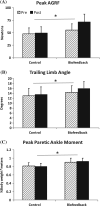Effects of real-time gait biofeedback on paretic propulsion and gait biomechanics in individuals post-stroke
- PMID: 29457532
- PMCID: PMC5901660
- DOI: 10.1080/10749357.2018.1436384
Effects of real-time gait biofeedback on paretic propulsion and gait biomechanics in individuals post-stroke
Abstract
Objectives Gait training interventions that target paretic propulsion induce improvements in walking speed and function in individuals post-stroke. Previously, we demonstrated that able-bodied individuals increase propulsion unilaterally when provided real-time biofeedback targeting anterior ground reaction forces (AGRF). The purpose of this study was to, for the first time, investigate short-term effects of real-time AGRF gait biofeedback training on post-stroke gait. Methods Nine individuals with post-stroke hemiparesis (6 females, age = 54 ± 12.4 years 39.2 ± 24.4 months post-stroke) completed three 6-minute training bouts on an instrumented treadmill. During training, visual and auditory biofeedback were provided to increase paretic AGRF during terminal stance. Gait biomechanics were evaluated before training, and during retention tests conducted 2, 15, and 30 minutes post-training. Primary dependent variables were paretic and non-paretic peak AGRF; secondary variables included paretic and non-paretic peak trailing limb angle, plantarflexor moment, and step length. In addition to evaluating the effects of biofeedback training on these dependent variables, we compared effects of a 6-minute biofeedback training bout to a non-biofeedback control condition. Results Compared to pre-training, significantly greater paretic peak AGRFs were generated during the 2, 15, and 30-minute retention tests conducted after the 18-minute biofeedback training session. Biofeedback training induced no significant effects on the non-paretic leg. Comparison of a 6-minute biofeedback training bout with a speed-matched control bout without biofeedback demonstrated a main effect for training type, with greater peak AGRF generation during biofeedback. Discussion Our results suggest that AGRF biofeedback may be a feasible and promising gait training strategy to target propulsive deficits in individuals post-stroke.
Keywords: Feedback; gait biomechanics; hemiparesis; locomotor training; motor learning; push-off; walking.
Figures



Similar articles
-
Effects of unilateral real-time biofeedback on propulsive forces during gait.J Neuroeng Rehabil. 2017 Jun 6;14(1):52. doi: 10.1186/s12984-017-0252-z. J Neuroeng Rehabil. 2017. PMID: 28583196 Free PMC article. Clinical Trial.
-
Comparison of the Immediate Effects of Audio, Visual, or Audiovisual Gait Biofeedback on Propulsive Force Generation in Able-Bodied and Post-stroke Individuals.Appl Psychophysiol Biofeedback. 2020 Sep;45(3):211-220. doi: 10.1007/s10484-020-09464-1. Appl Psychophysiol Biofeedback. 2020. PMID: 32347399 Free PMC article.
-
Immediate improvements in post-stroke gait biomechanics are induced with both real-time limb position and propulsive force biofeedback.J Neuroeng Rehabil. 2023 Mar 31;20(1):37. doi: 10.1186/s12984-023-01154-3. J Neuroeng Rehabil. 2023. PMID: 37004111 Free PMC article. Clinical Trial.
-
Paretic propulsion as a measure of walking performance and functional motor recovery post-stroke: A review.Gait Posture. 2019 Feb;68:6-14. doi: 10.1016/j.gaitpost.2018.10.027. Epub 2018 Oct 25. Gait Posture. 2019. PMID: 30408710 Free PMC article. Review.
-
Effectiveness of rehabilitation interventions to improve paretic propulsion in individuals with stroke - A systematic review.Clin Biomech (Bristol). 2020 Jan;71:176-188. doi: 10.1016/j.clinbiomech.2019.10.021. Epub 2019 Oct 21. Clin Biomech (Bristol). 2020. PMID: 31770660
Cited by
-
These legs were made for propulsion: advancing the diagnosis and treatment of post-stroke propulsion deficits.J Neuroeng Rehabil. 2020 Oct 21;17(1):139. doi: 10.1186/s12984-020-00747-6. J Neuroeng Rehabil. 2020. PMID: 33087137 Free PMC article. Review.
-
Simple within-stride changes in treadmill speed can drive selective changes in human gait symmetry.PLoS One. 2023 Oct 26;18(10):e0287568. doi: 10.1371/journal.pone.0287568. eCollection 2023. PLoS One. 2023. PMID: 37883477 Free PMC article.
-
Trailing limb angle is a surrogate for propulsive limb forces during walking post-stroke.Clin Biomech (Bristol). 2019 Jul;67:115-118. doi: 10.1016/j.clinbiomech.2019.05.011. Epub 2019 May 9. Clin Biomech (Bristol). 2019. PMID: 31102839 Free PMC article.
-
Real-Time Visual Kinematic Feedback During Overground Walking Improves Gait Biomechanics in Individuals Post-Stroke.Ann Biomed Eng. 2024 Feb;52(2):355-363. doi: 10.1007/s10439-023-03381-0. Epub 2023 Oct 23. Ann Biomed Eng. 2024. PMID: 37870663 Free PMC article.
-
Immediate Effect on Ground Reaction Forces Induced by Step Training Based on Discrete Skill during Gait in Poststroke Individuals: A Pilot Study.Rehabil Res Pract. 2020 May 19;2020:2397374. doi: 10.1155/2020/2397374. eCollection 2020. Rehabil Res Pract. 2020. PMID: 32509351 Free PMC article.
References
-
- Bowden MG, Balasubramanian CK, Neptune RR, Kautz SA. Anterior-posterior ground reaction forces as a measure of paretic leg contribution in hemiparetic walking. Stroke. 2006;37(3):872–876. - PubMed
-
- Balasubramanian CK, Bowden MG, Neptune RR, Kautz SA. Relationship between step length asymmetry and walking performance in subjects with chronic hemiparesis. Arch Phys Med Rehabil. 2007;88(1):43–49. - PubMed
-
- Neptune RR, Kautz SA, Zajac FE. Contributions of the individual ankle plantar flexors to support, forward progression and swing initiation during walking. J Biomech. 2001;34(11):1387–1398. - PubMed
-
- Chen G, Patten C, Kothari DH, Zajac FE. Gait differences between individuals with post-stroke hemiparesis and non-disabled controls at matched speeds. Gait Posture. 2005;22(1):51–56. - PubMed
Publication types
MeSH terms
Grants and funding
LinkOut - more resources
Full Text Sources
Other Literature Sources
Medical
